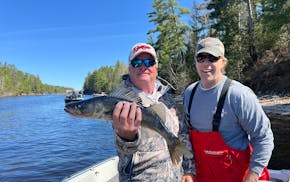Minnesota's greatest mystery isn't whether the Kensington Runestone is authentic (would a guy named Olof Ohman fib?), whether Marjorie Caldwell masterminded the murder of Duluth heiress Elizabeth Congdon (at trial, Caldwell knitted, and was acquitted), or if Marshall County Deputy Sheriff Val Johnson was in fact attacked by aliens on that dark western Minnesota night in 1979 (sure, like, why not?).
No, the state's biggest puzzle is how to catch walleyes in midsummer.
It's then that these tasty finned specimens depart from their shallow-water spawning and post-spawning haunts for locations and depths unknown.
Unknown … except to a relative handful of experts.
In 10 easy-to-remember tips, here's how they unravel Minnesota's midsummer walleye riddle.
10
"As water warms in June, walleyes migrate to cooler water," said Paul Radomski, a Minnesota fisheries biologist and author of "Walleye: A Beautiful Fish of the Dark." "Cooler water has a lake's highest oxygen levels, which fish like, and the coolest water is typically found at lake bottoms, or near them. Temperature, oxygen and forage all affect walleye summertime locations and behavior.''
9
True enough, said guide Tony Roach, who fishes Mille Lacs, Winnie, Cass and other walleye hotspots. "But keep in mind Mille Lacs and other Minnesota lakes have zebra mussels that have made them far clearer and, in many cases, their walleyes far spookier. Consequently, you've got to get your bait away from your boat to catch fish. Keep in mind also that while Mille Lacs walleyes in summer might be in 20 or 25 feet of water, I often find them suspended. So I often keep my baits 2 to 6 feet off the bottom."
8
Bait presentation is more critical than most anglers think, said Leech Lake guide Bob Landreville. "If I'm using a jig and a leech or other bait for walleyes while bobber fishing, or even while pulling a spinner, I'll use as small a jig as I can. Usually this means a crappie jig or ice-fishing jig. Color can be important, too. If it's sunny, I like a gold jig. If overcast, a green or blue jig."
7
"In the Brainerd area, after walleyes spawn, they often can be found in or along the edges of lake vegetation, or 'weeds,'" said Marv Koep, a semi-retired guide and former owner of Koep's Nisswa Bait and Tackle, original home of the Nisswa Guides League. "At that time, in late May up until about now, I'll fish them with a bobber and a #2 hook with a leech on the edges or right in the vegetation. Redtail chubs are my favorite bait, and I hook them through the tail so they can swim and create action. But they're hard to find and they're expensive."
6
"On Rainy Lake, I call mid- to late June a transition time for walleyes," said Mike Williams, who guided on Rainy for about 55 years before retiring. "One trick on windy days — and the windier the better — to catch walleyes is to fish windward shores. I'll fish in 2 feet of water, 4 feet or 8 feet, trolling a hammered gold spinner with a swivel and, say, a 4 foot leader, with a plain hook. Leeches or shiners work best."
5
Remember, said Radomski, walleyes — thanks to their wall-eyes — can see well in low light. But they can't tolerate bright light. So they generally hunt during low light conditions, such as during evenings or at night. "Minnows and other fish that walleyes eat can't see as well in low light, which makes walleyes in those conditions efficient predators," Radomski said. "They're also more vulnerable to anglers at that time."
4
Because light-averse walleyes often hang out in relatively deep water during daytime — when most people fish and when guides must catch fish for their clients — summertime walleye anglers must oftentimes go deep. "On Leech," said Landreville, "I'll pull spinners on the deeper humps 20 to 25 feet down using night crawlers or leeches. I like using colors to match the hatches that take place on Leech. The crayfish just molted and are getting new shells, so orange and black jigs or spinners work to match their color."
3
"The cool thing about Mille Lacs," Roach continued, "is that there are so many walleyes in the lake, there's no wrong way to fish them. You can catch them pulling bottom bouncers and spinners. Or, depending on the wind and time of day, you can jig or bobber fish. If they're feeding, you can get them to bite. But again, with the clear water, you have to keep your boat away from them. Consequently, I vertical jig less now than I once did, and pitch baits and long-line more often."
2
Which live bait is best in summer? Minnows don't get much love from walleye anglers in the summer. Is it because they don't keep as well in the warm months as 'crawlers and leeches, and therefore aren't used as often in late June, July and August — whereas in May they're the walleye angler's bait of choice? Hard to say. But best to bring a smorgasbord of baits.
1
Finally, from Radomski: "Guides and other professionals are better anglers than the rest of us because, after dedicating so much time to their craft, they know what should work at particular times and places. If it doesn't, they're confident enough in their skills and experience to adapt. Maybe they'll change lures or baits or presentation or locations. Less experienced anglers in the same situations don't necessarily know how to adjust. Experience makes the difference."

Anderson: In early June, Minnesota fish are begging to be caught. Won't you help?

Anderson: Tails wagging, DNR officers' dogs find lost people and missing evidence
Anderson: Punish poachers more
Anderson: The Chainsaw Sisters Saloon is gone, but the Echo Trail is still a pathway to possibilities




